in my program i have taken figure first then i import figue into canvas. Then i import canvas into scroll area. when i run my program ,then if i turn left scroll the yaxis tick label goes hide or i turn right scroll the yaxis tick label goes also hide. i have taken two axis. axis,axis2. i have set axes2.yaxis.tick_right() and axes.yaxis.tick_right().
I want that the yaxis tick label will stay at right side and alyas visible, whatever i turn scroll left or right .
import sys
from matplotlib.backends.backend_qt5agg import FigureCanvasQTAgg as FigureCanvas
import matplotlib.pyplot as plt
from matplotlib.figure import Figure
from PyQt5.QtWidgets import QMainWindow,QVBoxLayout
from PyQt5.QtWidgets import QApplication
from PyQt5 import QtCore, QtGui, QtWidgets
import datetime
from matplotlib.dates import num2date, date2num
from mpl_finance import candlestick_ochl as candlestick
import numpy as np
import matplotlib.ticker as ticker
import matplotlib.dates as mdates
import pylab as pl
class MainWindow_code_serarch(object):
def setup_code_serarch(self, MainWindow):
MainWindow.setObjectName("MainWindow")
MainWindow.resize(870, 680)
self.centralwidget = QtWidgets.QWidget(MainWindow)
self.centralwidget.setObjectName("centralwidget")
self.verticalLayoutWidget1 = QtWidgets.QWidget(self.centralwidget)
self.verticalLayoutWidget1.setGeometry(QtCore.QRect(17, 30, 741, 13))
self.verticalLayoutWidget1.setObjectName("verticalLayoutWidget")
self.verticalLayout1 = QtWidgets.QVBoxLayout(self.verticalLayoutWidget1)
self.verticalLayout1.setContentsMargins(0, 0, 0, 0)
self.verticalLayout1.setObjectName("verticalLayout1")
self.verticalLayoutWidget = QtWidgets.QWidget(self.centralwidget)
self.verticalLayoutWidget.setGeometry(QtCore.QRect(17, 10, 940, 603))
self.verticalLayoutWidget.setObjectName("verticalLayoutWidget")
self.verticalLayout = QtWidgets.QVBoxLayout(self.verticalLayoutWidget)
self.verticalLayout.setContentsMargins(0, 0, 0, 0)
self.verticalLayout.setObjectName("verticalLayout")
self.figure = Figure(figsize=(100,7.2), dpi=80, facecolor='k')
self.canvas = FigureCanvas(self.figure)
self.widget = QtWidgets.QWidget()
self.scroll_area = QtWidgets.QScrollArea(self.widget)
self.scroll_area.setWidget(self.canvas)
self.verticalLayout.addWidget(self.scroll_area)
axes,axes2 = self.figure.subplots(nrows=2, sharex=True)
data = {
'date': ['2018/10/30', '2018/11/03', '2018/11/04', '2018/11/05', '2018/11/07', '2018/11/10', '2018/11/11'],
'open': [8824, 8726.31, 8642.14, 8531.51, 8630.25, 8602.50, 8640.22],
'high': [8858, 8748.60, 8551.36, 8653.16, 8476.69, 8630, 8570.56],
'low': [8688, 8743.67, 8550.76, 8449.50, 8631.83, 8602.18, 8743.22],
'close': [8820, 8747.17, 8550.52, 8553., 8517.10, 8628.78, 8588.52],
'volume': [17759.56, 120000.17, 18739.52, 38599.50, 16517.10, 17723.78, 15588.52]
}
x = date2num([datetime.datetime.strptime(d, '%Y/%m/%d').date() for d in data['date']])
t= np.arange(len(data['date']))
candle_trace = zip(t, data['open'], data['high'], data['low'], data['close'], data['volume'])
candlestick(axes, candle_trace, width=.75, colorup='g', colordown='r')
axes2.plot(t, [1, 2, 3, 4, 7, 8, 9])
axes.set_position([0.02, 0.37, 0.88, 0.6])
axes2.set_position([0.02, 0.15, 0.88, 0.22])
axes.tick_params(axis='both', color='#ffffff', labelcolor='#ffffff')
axes.yaxis.tick_right()
axes2.tick_params(axis='both', color='#ffffff', labelcolor='#ffffff')
axes2.grid(color='lightgray', linewidth=.5, linestyle=':')
axes.grid(color='lightgray', linewidth=.5, linestyle=':')
axes2.yaxis.tick_right()
axes.autoscale_view()
axes2.autoscale_view()
axes.set_facecolor('#041105')
axes2.set_facecolor('#041105')
# N = len(dates)
axes.set_xticks(range(0, len((x)), 1))
axes.set_xticklabels([mdates.num2date(d).strftime('%b-%d') for d in x])
axes.set_xticklabels([mdates.num2date(d).strftime('%Y-%m-%d') for d in x])
axes2.set_xticklabels([mdates.num2date(d).strftime('%Y-%m-%d') for d in x])
self.canvas.draw()
MainWindow.setCentralWidget(self.centralwidget)
self.menubar = QtWidgets.QMenuBar(MainWindow)
self.menubar.setGeometry(QtCore.QRect(0, 0, 246, 21))
self.menubar.setObjectName("menubar")
MainWindow.setMenuBar(self.menubar)
self.statusbar = QtWidgets.QStatusBar(MainWindow)
self.statusbar.setObjectName("statusbar")
MainWindow.setStatusBar(self.statusbar)
# self.pushButton.clicked.connect(self.graphShowCode)
self.retranslateUi(MainWindow)
QtCore.QMetaObject.connectSlotsByName(MainWindow)
def retranslateUi(self, MainWindow):
_translate = QtCore.QCoreApplication.translate
MainWindow.setWindowTitle(_translate("MainWindow", "MainWindow"))
# self.pushButton.setText(_translate("MainWindow", "OK"))
if __name__ == "__main__":
import sys
app = QtWidgets.QApplication(sys.argv)
MainWindow = QtWidgets.QMainWindow()
ui = MainWindow_code_serarch()
ui.setup_code_serarch(MainWindow)
MainWindow.show()
sys.exit(app.exec_())


